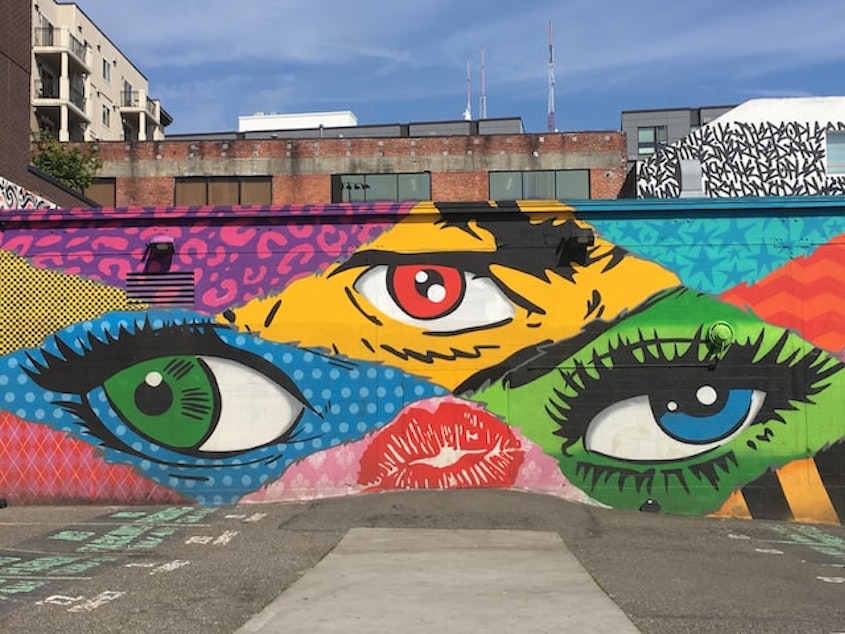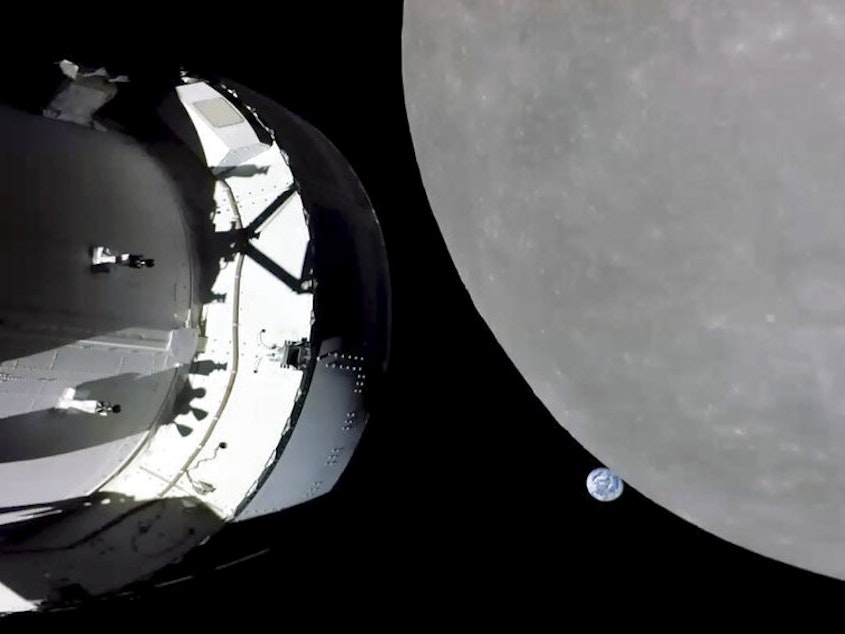When is graffiti art?: Today So Far

Seattle has a new effort to address graffiti. Could it work?
This post originally appeared in KUOW's Today So Far newsletter for November 21, 2022.
Imagine there is something that younger folks are interested in, and the older folks don't like it. This happens all the time. There's one thing the adults can do to ensure the younger folks lose interest — become interested in it themselves. Whatever it is, it will stop being cool. There's also something adults can do that will ensure younger folks double down on the offending interest — make it official and organize it.
I have a feeling that one of these two outcomes will happen in Seattle under the city's newest approach to graffiti.
Seattle Mayor Bruce Harrell is making graffiti a focus of his administration. He announced a series of measures being taken on the issue in October. The measures include increasing abatement and anti-graffiti volunteers. It also includes the Many Hands Art Initiative, which is run through the city's Office of Arts and Culture. Harrell proposed $940,000 for the effort. It basically seeks to find common ground between graffiti and public art, like murals, while leading youth programs for street art.
"It's an opportunity for new voices, it's an opportunity for communities to come together, it's an opportunity for all of us to have an ongoing solution of street art to this negative behavior of graffiti, whether it is violent or non-permission based," Royal Alley-Barnes, acting director of the Office of Arts and Culture, told KUOW's Mike Davis.
Alley-Barnes says that there are lines not to cross when it comes to street art, and that is what Seattle is pushing back on. One major line is the "negative behavior" Alley-Barnes spoke about. The city aims to have more positive and artistic displays on its streets.
Sponsored
Alley-Barnes points to the Martin Luther King Jr. mural on the corner of MLK Jr Way and Cherry Street. The mural was originally painted in the 1990s, and was recently redone by the original artist.
"The graffiti that was on there (before) was violent, it was misogynist, racist graffiti. This is what the mayor is talking about. That is not art. I don't care if the calligraphy is amazing, I don't care if it is done with the kinds of symbols we would see on a t-shirt ... no. Once it gets into all those negative, racist activities, once it gets into disrespect, and once it gets into premonition of violent behavior and violent statements — not acceptable."
Another line is throwing up paint on someone's business, or home, where it is not welcome.
"For me, it boils down to consent, or what is wanted or unwanted for a property owner," Mayor Harrell told KUOW. "There's a baseline, right? Hate crimes, racialized graffiti, things like that are graffiti and we want to not have that. That is non-negotiable."
On the other hand, Harrell says he has seen graffiti around Seattle, good art, and has wanted to find a way to foster that end of the spectrum.
Sponsored
"So I was thinking, 'Would this store owner, would they mind if someone took the time to do something more artistic, or with the consent of the store owner?' Now we're talking about art."
Seattle is doing something good by at least addressing graffiti, while also acknowledging that it isn't entirely a nuisance. But I do wonder how effective anything coming from an official angle can be on a scene that thrives on rebellion and adrenaline highs.
KUOW's previous reporting on graffiti indicates that much of the appeal is the "thrill" of sneaking and painting under the risk of getting caught. With that perspective, I'm curious how well it's going to go when city officials come around saying, "Hey kids, we get it. You want to buff and burn through life. But you know what is really cool? City-sanctioned street art!"
Then again, KUOW's reporting also states that the same artists who have run from police have also taken commissions for murals around town. After all, a graffiti artist may practice on a wall today, but eventually sell stencil art on used vinyl records at your local farmers market, or develop the skills worthy of a mural at Jupiter Bar.
Growing up in Olympia, artists would flock to the back alley of the Capitol Theater (and a bunch of other back alleys). On Bainbridge Island, spray paint covers the abandoned mill at Port Blakely. These are places with plenty of wall space, where graffiti artists and property owners, and the public, have an unwritten rule. This is where innovation and artistry can thrive. Maybe a few more alleys and unwritten rules around Seattle are what the city needs for those really wanting to improve their skills. For that, all you need is some sympathetic property owners and some alley space.
Sponsored
The other option, which I stated at the start of this newsletter, is for city officials to get super into graffiti, removing all the cool from it. That means Mayor Harrell is going to have to pick up some cans of spray paint, roll up his sleeves, and start tagging "1Seattle" all over town.
Check out Mike Davis' full story on this on KUOW's Soundside.
AS SEEN ON KUOW

James Rousseau (center in maroon shirt) dances at a powwow in the minimum security unit at Airway Heights Corrections Center last month. Powwows for Native American prison inmates in Washington state have been an annual tradition, but they were halted amid pandemic shutdowns. Now, the celebrations in the state’s 12 correctional facilities have returned. (Doug Nadvornick / Spokane Public Radio)
Sponsored
DID YOU KNOW?
Thomas Edison debuted the phonograph on this day, Nov. 21, in 1877. You may have heard that the first recorded sound was Edison singing "Mary had a little lamb," and it was recorded on a tinfoil cylinder. But most folks don't know that Edison was actually trying to invent a way to record telephone calls. At the time, it wasn't Edison's main focus. That whole light bulb thing was what he was really interested in, but he wouldn't give up on recorded sound for too long.
Ten years later, Edison began experimenting with a wax cylinder to capture sound, though he only thought it would be good for dictating messages. He should have taken a hint from his initial encounter with the the tinfoil — when he uttered a song and recorded it. Entertainment ended up being what this technology was successful for. By 1906, Edison had a national phonography company and was selling cylinder machines. In 1912, a spinning disc proved to be more ideal for recorded sound. It all began a new age of audio that we are still living in today — when audiophiles incessantly argue about the superiority of vinyl records.
ALSO ON OUR MINDS

Sponsored
NASA's Orion capsule buzzes the moon in a last step before humans revisit lunar orbit
NASA's Orion capsule reached the moon Monday, whipping around the far side and buzzing the lunar surface on its way to a record-breaking orbit with test dummies sitting in for astronauts. It's the first time a capsule has visited the moon since NASA's Apollo program 50 years ago, and represents a huge milestone in the $4.1 billion test flight that began last Wednesday.

